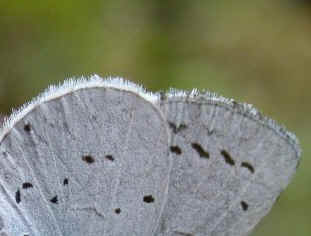Correct!
Mystery Picture Answers
No.20
|
|
The underside of the wings of the Holly Blue butterfly Celastrina argiolus. Both male and female of this species have a similar pattern and colouration on their underwings. This is usually one of the most common species of blue butterfly in Britain, in fact it is often referred to incorrectly as the Common Blue, which is in fact a different species! There are two generations of Holly Blue butterfly each year, although in some years the butterfly is scarce, due to a number of factors including the weather and the abundance of a parasitic wasp which preys specifically upon the Holly Blue caterpillars. Unlike the true Common Blue, the Holly Blue can be identified by the lack of any orange on its underwings and it has a tendency to fly at a much higher level around trees than other blue butterflies. The Holly Blue gets its name from the fact that the first generation of caterpillars in the spring feed on Holly, however the second brood of caterpillars tend to feed on the flower buds of ivy. The process of pupation occurs hidden behind bark, where the pupae are well protected throughout the winter before emerging in the spring as one of the first butterflies on the wing. |
|
Back to Mystery Picture Gallery

